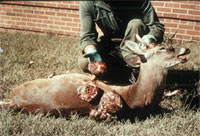Diseases and Parasites of Maryland Deer
Main_Content

Wildlife biologist dissects cutaneous fibroma on white-tailed deer carcass |
Cutaneous Fibroma
These warty hairless growths on the skin of white-tailed deer are caused by viruses and are believed to be spread by biting insects. The nonfatal tumors vary in size from less than an inch to more than 8 inches in diameter and can be smooth or warty with black to gray
coloration. Transmission to other animals such as livestock does not occur and no human infection has ever been reported. Human consumption of infected deer would only be compromised by extremely lrge tumors with
secondary infection.
|

Close-up of cutaneous fibroma on face of deer |
Acknowledgements:
Photographs are used with the permission of the Southeastern Cooperative Wildlife Disease
Study located at the University of Georgia, College of Veterinary Medicine.
For more information about white-tailed deer parasites and diseases, visit the Southeastern Cooperative Wildlife Disease Study Web site. The publication “Field Manual of Wildlife Diseases in the Southeastern United States” (third edition) by William R. Davidson and Victor F. Nettles explains and describes in detail parasites and diseases of southeastern birds and mammals. It is available for purchase through the website listed above.
Maryland Department of Natural Resources
Wildlife and Heritage Service
Tawes State Office Building, E-1
Annapolis MD 21401
410-260-8540
Toll-free in Maryland: 1-877-620-8DNR, Ext. 8540
E-Mail: [email protected]